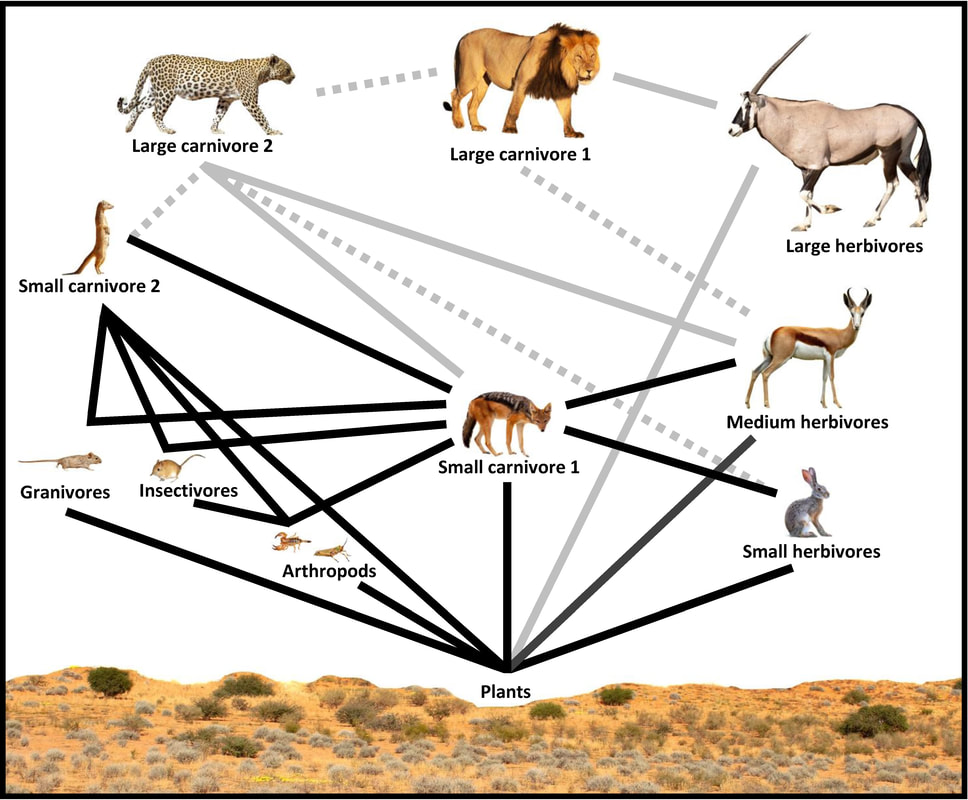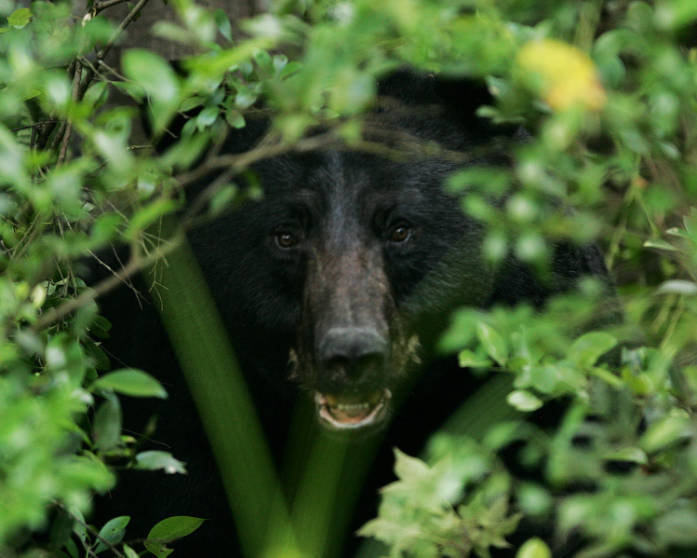CURRENT RESEARCH
Shining the spotlight on small carnivoresSmaller carnivores seldom get the conservation attention given to large carnivores, despite recent global analyses that have found they are declining at a similar rate to large carnivores. We are attempting to shift the narrative that all small to mid-ranking carnivores or mesocarnivores "releasing" (expanding their range and causing destruction to ecosystems) by highlighting their conservation need and the key role they play within ecosystems. In particular, we have provided 6 reasons why smaller carnivores are better sentinels for managers to focus monitoring on than large carnivores. This type of "middle-out" thinking drives how we investigate the structure of carnivore communities, and how we design projects to better understand the ecology of these smaller carnivores.
Related popular articles:
Why weasels and worms should represent the movement to conserve the natural world - Vox Weasels, not pandas, should be the poster animal for biodiversity loss - The Conversation A small carnivore crisis - The Wildlife Professional |
Recent Related Scientific Papers:
Do Linh San, E. In press. Time for a paradigm shift? Small carnivores' sensitivity highlights the importance of monitoring mid-rank predators in future global change studies. Journal of Animal Ecology. (Research highlight about our work) Jachowski, D.S., C.J. Marneweck, C. Olfenbuttel, and S.N. Harris. 2024. Support for the size-mediated sensitivity hypothesis within a diverse carnivore community. Journal of Animal Ecology 93:109-122. Marneweck, C., B.L. Allen, A. Butler, E. Do Linh San, S.N. Harris, A.J. Jensen, E.A. Saldo, M.J. Somers, K. Titus, M. Muthersbaugh, A. Vanak, S.W. Yu, and D.S. Jachowski. 2022. Middle-out ecology: Small carnivores as sentinels of global change. Mammal Review 52:471-479. Marneweck, C., A.R. Butler, L. Gigliotti, S. Harris, A. Jensen, M. Muthersbaugh, B. Newman, E. Saldo, K. Titus, S.W. Yu, and D.S. Jachowski. 2021. Shining the spotlight on small mammalian carnivores: global status and threats. Biological Conservation 255:109005. Jachowski, D.S., A. Butler, R.Y.Y. Eng, L. Gigliotti, S. Harris and A. Williams. 2020. Identifying mesopredator release in multi-predator systems: a review of evidence from North America. Mammal Review 50:367-381. |
Black bear ecology and managementWe have been doing research on black bears in South Carolina for over a decade, and starting in January 2024 we will be undertaking a multi-year study of black bear population dynamics. We are looking at questions related to patterns in abundance of bears across the upstate as well as how bears as the largest mammal in our system influence the behavior and distribution of other species.
Project collaborators: South Carolina Department of Natural Resources, US Geological Survey
|
Related Scientific Papers:
Azad, S., K. McFadden, J.D. Clark, T. Wactor and D. Jachowski. 2019. Applying spatially explicit capture-recapture models to estimate black bear density in South Carolina. Wildlife Society Bulletin 53:500-507. Azad, S., T. Wactor, and D. Jachowski. 2017. Demographic trends of a harvested black bear population in northwestern South Carolina. Ursus 28:56-65. Azad, S., T. Wactor, and D. Jachowski. 2017. Relationship of acorn mast production to black bear population growth rates and human-bear interactions in northwestern South Carolina. Southeastern Naturalist 16:235-251. |
Spotted skunksWe love a challenge, and prior to research accomplished by our team and others over the past decade, the eastern spotted skunk was one of the least understood carnivores in North America. We have conducted a series of studies on this species at multiple field sites from West Virginia to Florida, with our current research focusing on an intensive multi-year study in North Carolina.
We have also led conservation and research for this species nationally, founding the Eastern Spotted Skunk Cooperative Study Group in 2015 and serving as an advisor for the newly formed Island Spotted Skunk Study Group in California. Project collaborators: US Geological Survey, North Carolina Wildlife Resources Commission, Virginia Tech, Nemours Wildlife Foundation, South Carolina Department of Natural Resources, Florida Fish and Wildlife Conservation Commission, U.S. Fish and Wildlife Service, U.S. Forest Service Related popular articles:
Eastern Spotted Skunk Cooperative Study Group recognized - The Wildlife Society Disease, predation causing Appalachian spotted skunk decline - The Wildlife Society Shining the spotlight on spotted skunks - Wildlife in North Carolina |
Recent Related Scientific Papers:
Jachowski, D.S., C.J. Marneweck, C. Olfenbuttel, and S.N. Harris. 2024. Support for the size-mediated sensitivity hypothesis within a diverse carnivore community. Journal of Animal Ecology 93:109-122. Harris, S.N., T.J. Doonan, E.L. Hewett Ragheb and D.S. Jachowski. 2023. Home range, movement and activity patterns of the Florida spotted skunk (Spilogale putorius ambarvalis) in prairie habitat. Mammalian Biology doi.org/10.1007/s42991-023-00380-5. Siegfried, A.C., S.N. Harris, C. Olfenbuttel and D.S. Jachowski. 2023. Effects of sardines as an attractant on carnivore detection and temporal activity patterns at remote camera traps. Wildlife Research doi:10.1071/WR22196. Siegfried, A.C., S.N. Harris, C. Olfenbuttel and D.S. Jachowski. 2023. Den site selection of eastern spotted skunks in North Carolina. Mammal Research. https://doi.org/10.1007/s13364-023-00703-4. Dukes, C.G., D.S. Jachowski, S.N. Harris, M.L. Allen, L.E. Dodd, A.J. Edelman, S.H. LaRose, R.C. Lonsinger, and D.B. Sasse. 2022. A review of camera trapping methodology for eastern spotted skunks (Spilogale putorius). Journal of Fish and Wildlife Management e1944.. Marneweck, C., C. Forehand, C. Waggy, S. Harris, T. Katzner and D.S. Jachowski. 2022. Nocturnal light-specific temporal partitioning facilitates coexistence for a small mesopredator, the eastern spotted skunk. Journal of Ethology 40:193-198. Harris, S.N., J.L. Froehly, S.L. Glass, C.L. Hannon, E.L. Hewett Ragheb, T.J. Doonan, and D.S. Jachowski. 2021. High density and survival of a native small carnivore, the Florida spotted skunk (Spilogale putorius ambarvalis) in south-central Florida. Journal of Mammalogy 102:743-756. Butler, A., A. Edelman, R.Y.Y. Eng, W.M. Ford, S. Harris, E. Thorne, C. Olfenbuttel, and D.S. Jachowski. 2021. Demography of the Appalachian eastern spotted skunk (Spilogale putorius putorius). Southeastern Naturalist 20:95-109. Jachowski, D.S., and A. Edelman. 2021. Advancing small carnivore research and conservation: the Eastern Spotted Skunk Cooperative Study Group model. Southeastern Naturalist 20:1-12. Harris, S.N., C. Olfenbuttel, and D.S. Jachowski. 2021. Canine distemper outbreak in a population of eastern spotted skunks (Spilogale putorius). Southeastern Naturalist 20:181-190. |
Coastal island bobcatsOver the past several years we have been interested in the ecology of bobcats in coastal ecosystems. We have used a variety of approaches (camera traps, fecal DNA analysis, etc.) to relate land use and management conditions with bobcat and other carnivore occurrence and behavior.
In 2021 we initiated a multi-year project to assess the ecology of bobcats on islands - particularly Kiawah Island where there are concerns regarding population declines. Kiawah island is home to one of the most famous and well-studied bobcat populations, and we will be analyzing long-term historical datasets and conducting new field studies of bobcats to evaluate the demographic and behavioral responses of bobcats to land use change and exposure to rodenticides. Project website: Island Bobcat Research Project collaborators: Kiawah Island, Clemson University, South Carolina Department of Natural Resources, Tom Yawkey Wildlife Center |
Recent Related Scientific Papers:
Keating, M.P., E.A. Saldo, J.L. Frair, S.A. Cunningham, R. Mateo, and D.S. Jachowski. In press. Global review of anticoagulant rodenticide exposure in wild mammalian carnivores. Animal Conservation. Williams, A., L. Waits, J. Adams, and D.S. Jachowski. 2023. Dietary overlap of sympatric terrestrial mammalian carnivores in coastal impoundments of South Carolina. Southeastern Naturalist 22:481-497. |
Where are the weasels?Weasels are notoriously hard to study. If you have seen one in the wild, you know how fast and cryptic they can be. Perhaps that is part of the reason why their decline has gone unnoticed. Following our review of North America weasels in 2021, we created a weasel study group that involves biologists across the US collaboratively trialing new approaches to monitoring for weasels across their range. New tools could help us better understand where weasels persist, trends in their populations, and reasons behind declines over the past several decades across many parts of their historical ranges.
Project website: North American Weasel Working Group Related Popular Articles:
What Happened to North America's Weasels? - Meateater New Clemson University-led study reveals a declining weasel population in North America - Post and Courier Local Weasel Population Difficult to Assess as National Study Finds Species in Decline - EcoRI World's smallest carnivore, the least weasel, is going extinct - and scientists are scratching their heads trying to figure out why - Daily Mail Weasel out: Clemson-led study shows population of pint-sized predators dwindling - Clemson University |
Recent Related Scientific Papers:
Cheeseman, A.E., D.S. Jachowski, and R. Kays. 2024. From past habitats to present threats: Tracing North American weasel distributions through a century of climate and land use change. Landscape Ecology 39:104. Jachowski, D.S., S.M. Bergeson, S.R. Cotey, E. Croose, T.R. Hofmeester, J. MacPherson, P. Wright, C.A. Calderón-Acevedo, A.C. Dürst, G.B. Egloff, M.K. Hamed, P. Hapeman, S.N. Harris, K. Hassler, J. Humbert, D. Karp, R. Kays, J. Mausbach, D.J. Morin, J. Mos, S.S. Allué, L. Smith, J.P. Twining, C.R. Williamson, and K. Zub. 2024. Non-invasive methods for monitoring weasels: Emerging technologies and priorities for future research. Mammal Review 54:243-260. Jachowski, D.S., R. Kays, A. Butler, A.M. Hoylman, and M.E. Gompper. 2021. Tracking the decline of weasels in North America. PLoS ONE 16:e0254387. |
Proudly powered by Weebly




